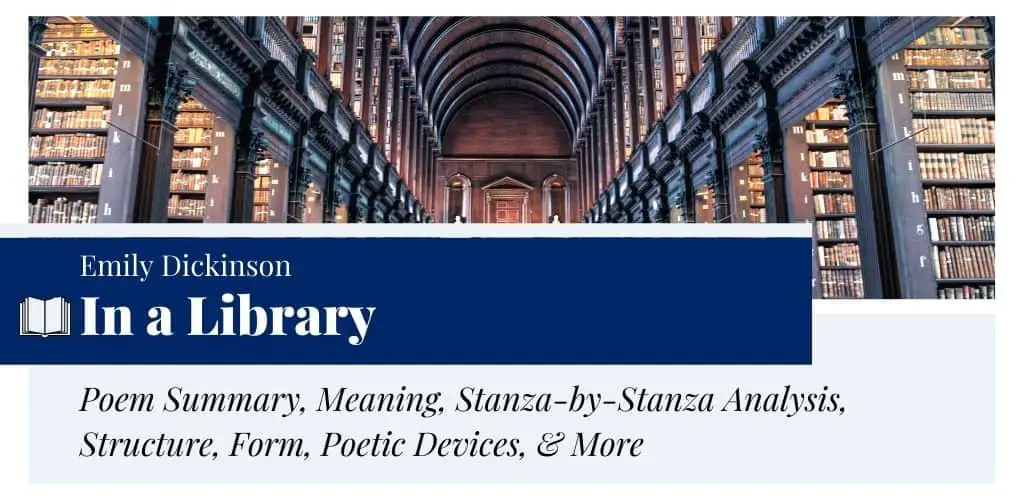In a Library by Emily Dickinson
“In a Library” is a classic of Emily Dickinson, written around 1862 and published in 1890 in her first collection, Poems, edited by two of her friends M. L. Todd and T. W. Higginson. Dickinson was born on 10th December 1830 in Amherst, Massachusetts. From her childhood, she was very studious and bright. She took a keen interest in writing poetry and works of literary appreciation. Most of Emily Dickinson’s poems are stylistically novel and marvelous. Her style of putting her thoughts on a piece of paper is very different from her contemporary poets. She spent most of her life in solitude, so the main themes one can encounter in her poems are loneliness and death.
- Read the full text of “In a Library” below:
In a Library (371) by Emily Dickinson A precious – mouldering pleasure – 'tis – To meet an Antique Book – In just the Dress his Century wore – A privilege – I think – His venerable Hand to take – And warming in our own – A passage back – or two – to make – To Times when he – was young – His quaint opinions – to inspect – His thought to ascertain On Themes concern our mutual mind – The Literature of Man – What interested Scholars – most – What Competitions ran – When Plato – was a Certainty – And Sophocles – a Man – When Sappho – was a living Girl – And Beatrice wore The Gown that Dante – deified – Facts Centuries before He traverses – familiar – As One should come to Town – And tell you all your Dreams – were true – He hved – where Dreams were born – His presence is Enchantment – You beg him not to go – Old Volumes shake their Vellum Heads And tantalize – just so – - from The Complete Poems of Emily Dickinson by Thomas H. Johnson (1955)

Summary
Dickinson’s “In a library” is a poem about the timelessness of an old book and the importance of the greatest source of knowledge, a library. In this poem, Dickinson expresses her love for the old books of a library. The books become a means for her escape into the antique world, the worlds of the prominent ancient writers. The setting of the poem is there in the title, i.e., a library. The poem’s speaker finds herself overwhelmed and loses track of time when she is around books. They nearly fill the empty void that Dickinson had in her life, the void of solitude, dejection, and sadness.
Meaning
Through her poem “In a Library,” Dickinson highlights the various facets of a library. She strikes a conversation with an old book as if it is a wise, old human being. It is at one hand a comforter to the speaker. On the other hand, the book is an ocean of knowledge and a great healer. The speaker experiences a “mouldering pleasure” while “warming” her mind with the knowledge of the book. It reminds her of other writers who sown the seed of hope in the past. She expresses her gratitude to them and tries to persuade the old book to stay a little longer. Sadly, in its present “mouldering” state, it cannot. Hence, Dickinson remarks, “Old volumes shake their vellum heads/ And tantalize, just so.”
Form, Rhyme Scheme, & Meter
“In a Library” by Emily Dickinson runs into seven quatrains (stanzas having four lines each). The first quatrain does not follow a specific rhyme and rhythm. However, the other stanzas strictly follow the ABCB rhyme scheme. It means the second and fourth lines end with a similar rhyme.
The speaker of the poem can be counted as the poet herself, who enjoys being around old books of a library and feels the warmth of knowledge while around them.
Regarding the setting, Dickinson sets this poem in a library. It is written from the first-person point of view with a grateful tone. In the last sections, the tone reflects the speaker’s longing and sadness for the deterioration of old books due to neglect.
Like other poems of Dickinson, this piece is composed of iambic tetrameter and iambic trimeter alternatively. Let’s have a look at the scansion of the first two quatrains:
A pre/-cious, mould/-ering plea/-sure ‘t is
To meet/ an an/-tique book,
In just/ the dress/ his cen/-tury wore;
A pri/-vi-lege,/ I think,
His ve/-ne-ra/-ble hand/ to take,
And war/-ming in/ our own,
A pas/-sage back,/ or two,/ to make
To times/ when he/ was young.
Poetic Devices
In Dickinson’s poem “In a Library,” one important literary device is Allusion.
Allusion
An allusion is an indirect reference to some author or work, especially in literature. “In a Library” has many allusions such as:
- “Plato” — Plato is considered the father of western political philosophy. He is also the creator of the “metaphysical theory of forms.”
- “Sophocles” — Sophocles is a legendary figure in the history of English literature. His best-known work Oedipus Rex is a primer for understanding the genre of tragedy.
- “Sappho” — Sappho was a Greek poet. In the ancient age, she was regarded as one of the greatest lyric poets, even given the titles “Tenth Muse” and “The Poetess.”
- “Beatrice” — Beatrice was the principal inspiration of Dante. She appears in Dante’s Divine Comedy and in his other works.
- “Dante” — Dante, the creator of the Divine Comedy, was an Italian poet and philosopher. He was one of the important poets of the Mediaeval Ages.
Let’s have a look at the other poetic devices used in the poem.
- Personification: It denotes human qualities to animals, objects, or abstract ideas. In the poem, “an antique book” is personified, described with all the living qualities, like having hands, a mind, wisdom, etc.
- Extended Metaphor: It is a form of metaphor that extends for multiple lines or stanzas; the “book” is an extended metaphor for a wise man from the antique age.
- Anaphora: When a word or phrase occurs at the beginning of consecutive lines, the technique is called anaphora. For instance, the term “His” is repeated at the beginning of lines 5-6, and “What” is repeated in lines 9-10.
- Alliteration: It is the occurrence of the same sound (vowel/consonant) at the beginning of words next to each other; like, “two, to” (repetition of the “t” sound), “mutual mind” (repetition of the “m” sound), “that Dante deified” (repetition of the “d” sound), “to town” (repetition of the “t” sound), etc.
Stanza-by-Stanza Analysis & Explanation
Stanza One
A precious, mouldering pleasure ‘t is
To meet an antique book,
In just the dress his century wore;
A privilege, I think,
Dickinson’s “In a Library” begins on a pleasant note. The poetic persona is extremely content and delightful that she is meeting an old friend of hers, “an antique book” in a “mouldering” library. The book is personified as an old acquaintance that wears a century-old dress. Its “dress” is a metaphor for an old “vellum” cover. From this reference, it can be inferred that this book is a classic. As the book dates back nearly a century, its cover seems extremely dull and pale to the speaker. She also believes that it belonged to a glorious era. Hence, it holds a sort of “privilege” to “meet” (having the opportunity to read) the classic by holding it in her own hands.
Stanza Two
His venerable hand to take,
And warming in our own,
A passage back, or two, to make
To times when he was young.
In the second stanza, Dickinson’s speaker expresses her feelings about her encounter with the old friend, i.e., the book. The speaker feels honored to hold its “venerable hand” as if the book is a great, wise man with several enriching facts in its store.
The book is depicted as a man of wisdom, intellect, and knowledge in this section. The speaker can feel the warmth while holding hands with it. She recollects all the memories she has with it. They both move back to the time when the book was young, latest, and popular.
The speaker feels overwhelmed with her eyes glittering in happiness. It is like meeting the person with whom one longs to have a chat.
Stanza Three
His quaint opinions to inspect,
His knowledge to unfold
On what concerns our mutual mind,
The literature of old;
In the next stanza, she explores several aspects the book as a wise man has to offer her. It has some “quaint opinions” (debatable theories) the poet does not agree with. It can also be a reference to the old wisdom available in the book.
The book has a vast ocean of “knowledge to unfold.” Hence, she keeps peeping through the books to have insight and clarity on the antique age. She further claims that they (the book and the poet) both share mutual thoughts. Their main concern is about the “literature of old.” The speaker is interested in knowing the intricacies of the old literature, and the book unfolds the popular topics from the age.
Stanza Four
What interested scholars most,
What competitions ran
When Plato was a certainty.
And Sophocles a man;
In this stanza, Dickinson goes back to the past with the mentions of the various literary figures. Her tone shows her deep interest in the legacy that the literary ancestors have left behind. She wants to know what exactly interested the ancient scholars and what they liked or abhorred.
The speaker is also curious to find out the ideas of “Plato” and “Sophocles” when they both were in full command in their time. She tries to ask what the major line of difference was and how one can identify the better one between them. Further, she alludes to “Plato” and “Sophocles.”
Plato was an Athenian philosopher best known for his work called the Republic. His dialogues deal with several aspects of metaphysics. On the other hand, Sophocles is one of the three ancient Greek tragedians whose plays have survived. His best-known works include Oedipus Rex, Antigone, etc.
Stanza Five
When Sappho was a living girl,
And Beatrice wore
The gown that Dante deified.
Facts, centuries before,
This stanza begins In continuation of the allusions to the ancient gems of literature from the previous stanza. Dickinson alludes to “Sappho,” a poet, alive back then, again tracing back to Ancient Greek literature. Sappho, known for her lyric poetry, is regarded as “The Poetess” and the “Tenth Muse.” Like Dickinson, Sappho’s poems are melodious in nature, written to be sung accompanied with music.
The next allusion that the poet has made is that of “Beatrice,” from the Divine Comedy written by the Italian poet Dante Alighieri. Dante adored Beatrice so much that his vast array of poetry was centered around her.
The reference of “the gown” represents Dante’s love for Beatrice, who “deified” (glorified with veneration and deep admiration) her like a goddess. All these references to the writers are the witness of Dickinson’s devotion to classical Greek and Italian literature. In this way, she takes readers along with her long back in time when those figures were at their prime, through the medium of an old book.
Stanza Six
He traverses familiar,
As one should come to town
And tell you all your dreams were true;
He lived where dreams were sown.
Dickinson, in this stanza, nostalgically recounts the supremacy of ancient Greek writings of art, philosophy, and myths. The “antique book,” which is full of knowledge, saw the transition of several ages. It can tell about the high reliance of western culture on Greek art and how their themes and concepts are still relevant and sound.
The word “dreams” represents the thoughts and ideas that a writer planted in the book long back. The new generation is reaping the crops of their “dreams” now, following their legacy. In this way, the seeds of knowledge and ideas are sown in the form of writing a book. After ages, when curious ones come across such writings, they come to understand that the “dreams” of the past are the “reality” they are living in.
Stanza Seven
His presence is enchantment,
You beg him not to go;
Old volumes shake their vellum heads
And tantalize, just so.
The last stanza of “In a Library” is more of a sad note as Dickinson is not ready to believe that it is time for the books to go. She cannot let the book go. She begs it “not to go” because the air around is enchanted with its wise spells. It has fumes of pleasure that the poet does not want to let go. She feels overwhelmed being around it, grasping all its knowledge, feeling less lonely than she is. So, seeing its deteriorating pages, she is hesitant to let it fade.
The “antique book,” on the other hand, tantalizes (teases) the poet, making fake promises to return. All the old books of the library start nodding, and they shake their “vellum heads” in unison. However, deep in her heart, Dickinson knows that she will not get this chance again. This is the time to wave “the book” a warm and heavy goodbye.
Historical Context
Emily Dickinson is one of the greatest American poets. Her poetry is still relevant in the contemporary world. She has lived most of her life alone, and hence, most of her poems showcase her state of loneliness, grief, and obsession with death. She witnessed the death of her parents when she was a child. Thus, many of her poems share the theme of death. By being on her own, for most of the time, writing became her only strength and the voice which we can hear until now through her works. The rest of her life was spent in misery and ailing health. Being lonely throughout her life, she was dragged to reading. Her love for ancient literature/books is portrayed in the poem “In a Library.”
Questions & Answers
Emily Dickinson’s poem “In a Library” is about “an antique book” from a library. The speaker compares the book to a wise old man with whom she spends some quality moments, diving back and forth in time, reminiscing on the Greek and Italian writers, and brooding over the drooping condition of other books of the library.
According to Dickinson, the books of Plato, Sophocles, Sappho, and Dante are still important to this day. In this poem, she gets lost in her thoughts while holding an original edition of an “antique book.”
In this poem, Dickinson reads an “antique book” from an old library. This book belongs to Ancient Greek literature as the speaker spends several lines recapitulating the names of some great Greek writers such as Plato, Sophocles, and Sappho.
According to the poet, books help us to relive the past. They are the window to the opinions of our forefathers, their concerns for the world, interests, traditions, and, most importantly, their dreams which have become our reality.
In this poem, Dickinson uses a number of literary devices such as allusion, personification, alliteration, etc.
Emily Dickinson was a keen observer, and her poetry has a variety of themes covering death, immortality, nature, and life. In this poem, she taps on the themes of books, reading, past, dream, mortality, and knowledge.
“In a Library” was published in Dickinson’s first collection of poetry, Poems (1890). It appears as the tenth poem in Book I, entitled “Life.”
Emily Dickinson’s poems include the use of long dashes, elision, and unconventional capitalization. Her poems are titleless. She is regarded as one of the greatest and most unique poets of all time.
Similar Poems about Books & Writing
- “The Writer” by Richard Wilbur — This piece is about a father’s concerns for his daughter, struggling while writing a short story.
- “Dreamtime” by Oodgeroo Noonuccal — This poem is an impassioned address to the ancestors who died protecting their culture.
- “Under a Certain Little Star” by Wislawa Szymborska — In this poem, Szymborska addresses a number of ideas, admitting her inadequacies as a poet.
- “Have you got a brook in your little heart” by Emily Dickinson — This poem taps on the themes of life, mortality, and death, comparing the soul to a brook.
External Resources
- About Ancient Greek Literature — Learn about the Greek writers, their works, and major themes.
- The Role of Libraries — Learn about the importance of libraries in society.
- Read the full text of Poems (1890) — Explore the first collection of Emily Dickinson’s poetry.
- Life of Emily Dickinson — Unfold the chapters of Dickinson’s Life and her poetic career.
- Poetic Style of Emily Dickinson — Discover the major characteristics of Dickinson’s poetry.
- Check out My Wars Are Laid Away in Books — Explore this enriching book on the life and poetic development of Emily Dickinson.






